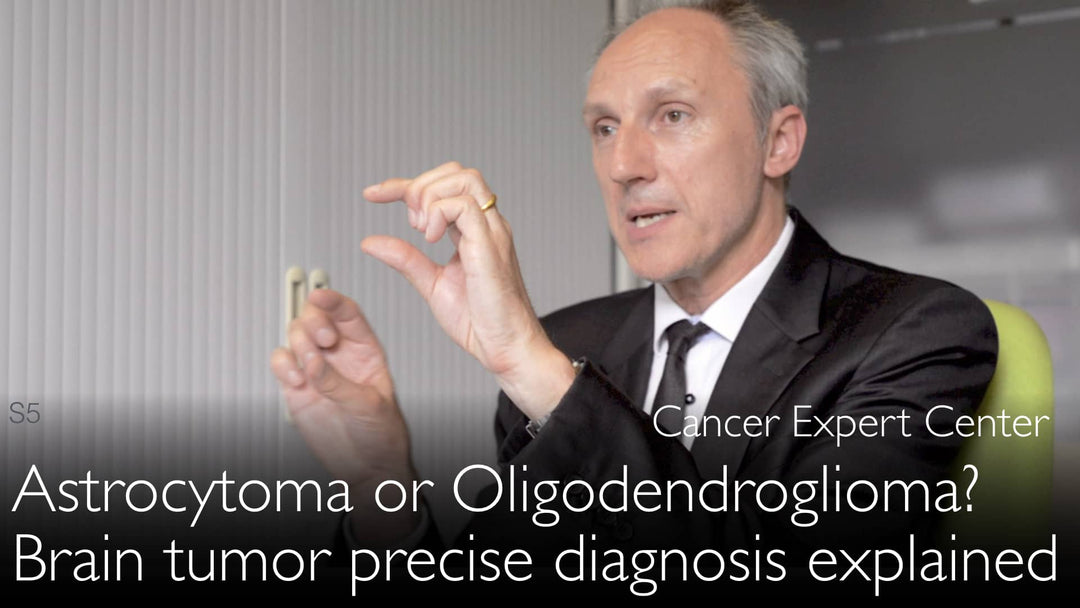The 1990s breakthrough discovery by Dr. Cairncross identified simultaneous loss of chromosome arms 1p and 19q as a hallmark of oligodendroglioma. Dr. Sebastian Brandner, MD, notes this co-deletion occurs in about 80% of oligodendrogliomas but rarely in other brain tumors. The presence of 1p/19q co-deletion predicts better response to chemotherapy and radiation in oligodendroglioma patients.
Molecular Testing for Oligodendroglioma vs Astrocytoma: Key Genetic Markers
Jump To Section
- Glioma Classification Challenges Before Molecular Testing
- 1p/19q Co-Deletion: The Oligodendroglioma Marker
- IDH Mutation as a Universal Glioma Indicator
- Evolution of Brain Tumor Diagnostic Methods
- How Molecular Testing Impacts Treatment Decisions
- Availability of Advanced Brain Tumor Testing
- Full Transcript
Glioma Classification Challenges Before Molecular Testing
Before molecular diagnostics, distinguishing between oligodendroglioma and astrocytoma relied solely on microscopic examination, which often led to diagnostic uncertainty. Dr. Sebastian Brandner, MD, explains that these gliomas appeared similar under traditional pathology methods. The introduction of genetic testing transformed neuropathology by providing objective biomarkers for precise tumor classification.
1p/19q Co-Deletion: The Oligodendroglioma Marker
The 1990s breakthrough discovery by Dr. Cairncross identified simultaneous loss of chromosome arms 1p and 19q as a hallmark of oligodendroglioma. Dr. Sebastian Brandner, MD, notes this co-deletion occurs in about 80% of oligodendrogliomas but rarely in other brain tumors. His UK neuropathology department began clinical testing for 1p/19q in 2003, with case volumes growing rapidly as the test became standard for treatment planning.
IDH Mutation as a Universal Glioma Indicator
Dr. Sebastian Brandner, MD, describes how the 2008 discovery of isocitrate dehydrogenase (IDH) mutations created a new diagnostic paradigm. Research by Dr. Andreas von Deimling showed all 1p/19q-deleted oligodendrogliomas carry IDH mutations, while IDH-mutant tumors without co-deletion are classified as astrocytomas. This dual-marker system now underpins the World Health Organization's glioma classification criteria.
Evolution of Brain Tumor Diagnostic Methods
From initial PCR-based techniques to modern sequencing, molecular testing methods have advanced significantly. Dr. Brandner's laboratory progressed from analyzing 10 cases annually in 2003 to serving as a national reference center. Current protocols combine chromosomal analysis with IDH1/2 mutation testing, providing comprehensive molecular profiles that guide clinical decisions for glioma patients.
How Molecular Testing Impacts Treatment Decisions
The presence of 1p/19q co-deletion predicts better response to chemotherapy and radiation in oligodendroglioma patients. Dr. Anton Titov, MD, highlights how molecular results directly influence treatment protocols - with co-deleted tumors often receiving combined modality therapy. IDH mutation status also affects prognosis, as IDH-mutant gliomas generally have slower progression than IDH-wildtype tumors.
Availability of Advanced Brain Tumor Testing
Dr. Sebastian Brandner, MD, emphasizes the UK neuropathology network's commitment to making molecular testing widely accessible. His center serves a population of 10-12 million, processing samples from multiple hospitals. While most major centers now perform these tests locally, ongoing standardization ensures consistent results across institutions for optimal patient care.
Full Transcript
Dr. Anton Titov, MD: There are many types of brain tumors, but one important category is oligodendroglioma. Oligodendrogliomas are a relatively common form of brain tumor. Advanced molecular analysis in oligodendroglioma plays a crucial role in treatment planning and patient risk stratification.
Dr. Sebastian Brandner, MD: There are two key aspects in the field: research and diagnostics. While both are essential, I first focus on the diagnostics.
In the early 1990s, Dr. Cairncross discovered a distinctive genetic marker in oligodendroglioma — the co-deletion of two chromosomal arms: the short arm of chromosome 1 (1p) and the long arm of chromosome 19 (19q). This breakthrough finding quickly expanded in scope and eventually entered clinical diagnostics.
Over the past 10 to 15 years, molecular diagnostics have become increasingly important, as treatment decisions now often rely on the detection of the 1p/19q co-deletion.
In 2008, an American research consortium discovered mutations in the enzyme isocitrate dehydrogenase (IDH) in oligodendrogliomas and astrocytomas. A year later, IDH mutations were also identified in certain soft tissue tumors and hematological cancers.
Shortly afterward, Dr. Andreas von Deimling in Heidelberg conducted in-depth research on how IDH mutations relate to these gliomas. His team confirmed that the 1p/19q co-deletion always coexists with IDH mutation in oligodendrogliomas, while a separate group of IDH-mutant brain tumors without the co-deletion are classified as astrocytomas.
Dr. Sebastian Brandner, MD: My department established 1p/19q molecular testing in 2003, initially testing around 10 brain tumors per year. By 2004–2005, we had scaled up to 20–30 tests annually, further refining our diagnostic methods using PCR-based techniques.
Today, my laboratory provides this molecular diagnostic service to neuropathology departments across the UK.
The neuropathology society strongly encourages establishing these diagnostic tests locally, ensuring that patients can access accurate brain tumor diagnosis without delays. While most major neuropathology centers in the UK conduct their own testing, my department serves a particularly large catchment area — covering 10 to 12 million people — and receives brain tumor samples from many hospitals.
Oligodendroglioma and astrocytoma are two primary types of glioma brain tumors. Precise classification is vital for determining optimal treatment strategies.
In some cases, molecular testing is also performed on tumors expected to be negative for these mutations, in order to confirm pathology and understand tumor biology.
Dr. Anton Titov, MD: A deeper understanding of molecular biomarkers allows for sharper and more clearly defined diagnoses, ultimately leading to better patient outcomes.




